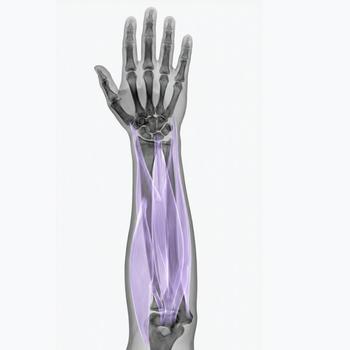Quick version
The forearm is central to movement, strength, and fine motor skills in the arm and hand.
- Consists of the radius and ulna
- Contains muscles that control the wrist and fingers
- Important nerves control sensation and movement
- Common problems include overexertion and nerve compression
- Treatment is tailored to the cause and symptoms
What is the forearm?
The forearm is measured between the elbow and the wrist. It contains two long bones – one called the radius and the other called the ulna. The forearm also consists of a network of muscles, tendons, nerves, and blood vessels. It enables movements such as supination, which is when you turn your palm up, and pronation, which occurs when you turn your palm down.
The bone structure of the forearm
The bones of the forearm, the radius and ulna, are connected to each other via a ligament called the interosseous membrane, which provides stability and support for movement.
Muscles and movements
The muscles in the forearm are divided into two main groups - one is the flexor muscles (front side) and the other is the extensor muscles (back side). These muscles are responsible for bending and extending the fingers, wrist and elbow.
Nerves and blood vessels
There are several nerves in the forearm, but the most important nerves are the median, ulnar and radial nerves. The blood supply is provided by the radial and ulnar arteries. These structures are crucial for sensation and motor function in the hand and fingers.
Common injuries and problems
In the forearm, pain can often be due to muscle overexertion, inflammation of the tendons (tendinitis), nerve compression or fractures. Other examples of related conditions are tennis elbow and carpal tunnel syndrome.
Examination and treatment
Diagnosis is often made through clinical examination of the forearm and imaging studies such as X-rays or MRI. Treatment varies depending on the cause and may include rest, physical therapy, medication, or surgery.
Relevant symptoms
- Pain in the forearm
- Numbness or tingling in the hand
- Weak grip strength
- Swelling or stiffness
- Tenderness to pressure
- Limited wrist mobility
Related conditions and diagnoses
- Tennis elbow (lateral epicondylitis)
- Golfer's elbow (medial epicondylitis)
- Carpal tunnel syndrome
- Tendinitis in the wrist or elbow
- Fracture of the radius or ulna
- Nerve compression (e.g. cubital tunnel syndrome)






















